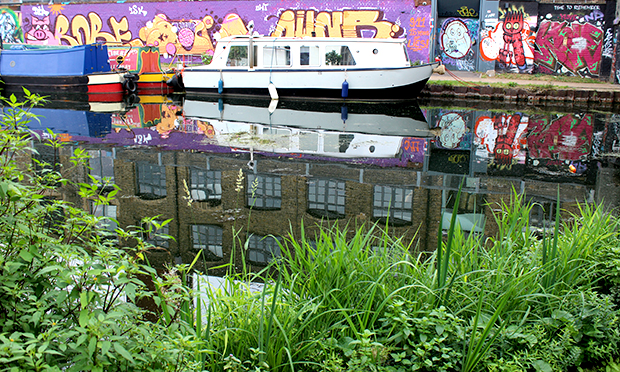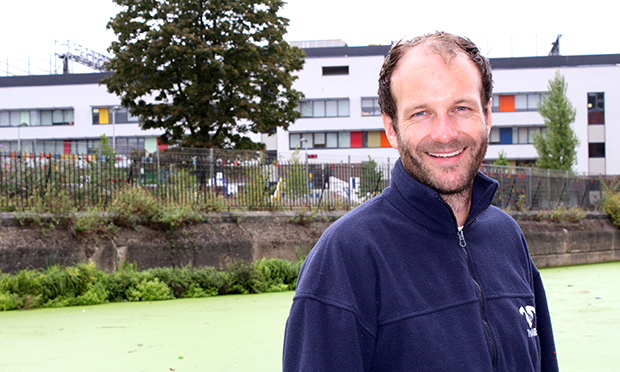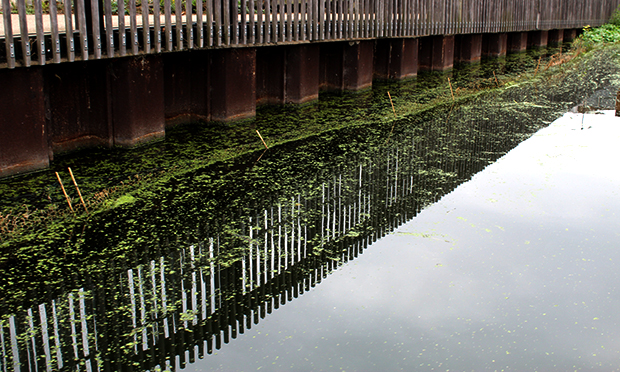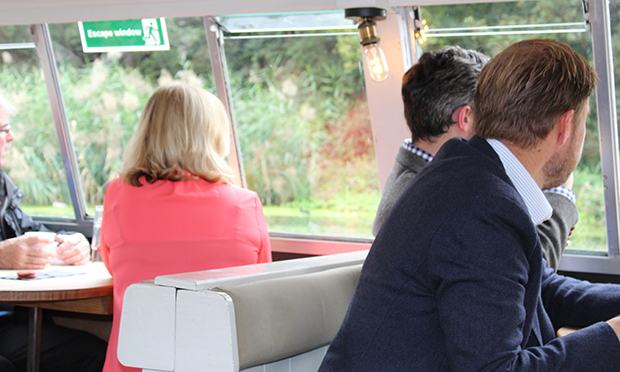‘Avid reeders’ use much-maligned plant to tackle pollution in River Lea

Reeding up: the newest design sees reeds moved from land to water. Photograph: Max Eckersley
Phragmites is a plant with a bad reputation. In some parts of the world, it’s known as a “terrorist”. In Canada, they call it the “rampaging monster”.
The invasive reed – not helped by a name that brings to mind a grenade – can explode out of control and wreak havoc on waterways. Such is the negativity towards the species, there are now dedicated ‘Fight the Phrag’ movements in certain countries.
But experts say we shouldn’t be too quick to judge – that this much-maligned plant is actually one of the good guys. The reason? It is perfect for getting rid of pollutants.
Environmental specialists have praised phragmites for rescuing dirty rivers across the world, including Europe’s second-longest, the mighty Danube.
The plant is even credited with saving Venice’s decaying buildings – artificial reedbeds, installed by microbiologists, have cleaned up the heavily-polluted water propping up Italy’s ‘Floating Island’.
And if it’s good enough for the City of Water, it’s good enough for East London’s Lee Navigation, where charity Thames21 is on a similar mission. It’s called Project Reedbed.

Reedbed army commander-in-chief: Ben Fenton runs Thames21’s project. Photograph: Max Eckersley
I joined Ben Fenton, the project’s commander-in-chief, for a cruise along the Lea, to see first-hand the work he and his “reedbed army” of volunteers have been doing to help one of the UK’s most contaminated rivers.
Arriving at the charity’s tiny office in Bow Locks, the pollution is plain to see. A huge swathe of the surrounding canal is hidden under a layer of luminous green duckweed. If it wasn’t for the paddling birds and the scattering of plastic bottles bobbing up and down, you’d be forgiven for thinking it was tarmac.
A couple of guys are doing their best to clear it away – using the aquatic equivalent of a leaf-blower – but it’s a time-consuming process with little to show for it. The duckweed quickly consumes the area they’ve just emptied.
“Duckweed is the excess growth of vegetation in a nutrient-rich environment, and it’s caused by high levels of pollution,” Fenton tells me.
“It’s not good because it covers up the surface so no light can reach the bottom of the river, and all the plants below die.”
The Lea catchment provides a lot of the capital’s drinking water, but East London’s industrial past means the river is heavily polluted. This comes from three main sources, Fenton explains.
Firstly, a lot of street drains flow into the river, so all the muck left behind on roads by lorries and cars ends up in the Lea.
Overflowing sewers are another culprit.
“The sewage system was built a long, long time ago and it can’t really cope with today’s population. Just a little bit of rain means sewage starts to creep into the river as well,” Ben says.
The other cause, believe it or not, is misconnected plumbing.
“It’s quite common, unfortunately, and it means we’re putting waste water down the surface water drains and it’s going straight into the river as well,” he adds.
Although East London has seen massive regeneration over the past few years, particularly since the Olympics in 2012, Fenton says the amount of pollution hasn’t really changed.
“The Olympics has helped more in terms of raising awareness. There are lots of blocks of flats popping up, overlooking the river – why didn’t we think of that before? – so people are more interested in protecting it,” he explains.
For the last five years, Thames21 has been tackling the pollution by recruiting volunteers to maintain and plant reedbeds along the walls of the river, accessing them by using canoes.
The reeds are either planted straight into the mud at the bottom of the river or, like in Venice, into man-made floating mats, woven in Southern India out of a natural material called coir.
And the reed of choice is the notorious phragmites, which Ben describes as the “ideal plant” for cleaning up the river.
“It has a natural filter for breaking down pollutants. Unfortunately, we’re not always allowed to use it by the Canal & River Trust because it encroaches on the channel. That’s why we have to use different types of reedbeds.
“The floating reedbeds are used because we’re not always allowed to plant into the mud at the bottom of the river. But they’re not ideal – they cost thousands of pounds and they don’t last that long.
“The natural reedbeds last hundreds of years, whereas the floating ones probably last 15 or 20 before they need to be replanted,” he tells me.
As we poodle along in our canal boat – filled with artists, geologists, amateur photographers and, most importantly, the charity’s paymasters – Fenton talks about another benefit of the reedbeds: creating habitats for local wildlife.

Beak district: wild fowl sometimes eat the reeds before they can develop. Photograph: Max Eckersley
Wild fowl, swans, fish and dragonflies rely on the tall reeds for protection, breeding and nesting. The fowl clearly didn’t get the memo, though, because they’ve eaten a few of the young reedbeds before they’ve had a chance to establish themselves.
To keep the coots at bay and allow the plants to develop, the charity uses camouflage fencing, which is understandably hard to spot, but still not ideal.
The team is constantly experimenting with new designs, and as we pull up at our final destination, a brewery in the shadow of the Olympic Stadium, we get a glimpse of Thames21’s latest baby.
This young reedbed was planted on land, away from prying beaks and fluctuating water levels, so it had plenty of nutrients from the soil before being moved into the water. It is an impressive sight – as beautiful as it is necessary.

Cash stream: the charity’s backers were invited to see the reedbeds. Photograph: Max Eckersley
But all this work comes at a cost. Project Reedbed has been supported by Tesco, Thames Water, the Environment Agency and HSBC. Unfortunately, the latter’s funding is soon coming to an end, and Fenton tells me it is a “constant battle” to raise money.
That is why the charity has to lean on volunteers for much of its work, which extends to education, research, sustainable drainage and litter removal, amongst other things.
“We’re all about involving the community,” Fenton says.
And that includes reedbeds. Not only can local residents help out with planting and maintaining the reeds, they’ll also be able to vote on where to put them.
“We’ve chosen ten sites for new reedbeds along the Lee Navigation, and the local public will be able to vote for their favourite five.
“In the near future, we’ll hold an online poll, and then we’ll try and engage the voters and get them out to help plant them.
“Not only that, but on 20 October, we’re starting our free training programme: a one-day, accredited course that will teach people how to maintain these reedbeds into the future.
“We want locals to take ownership of their rivers,” he says.
Just as plants need water, our waterways needs plants to survive. Most of all, they need dedicated, passionate people like Ben Fenton and his colleagues to look after them.
The more, the merrier.
For more information on Thames21, or if you’re interested in volunteering, please visit the charity’s website.
